What is Project Scope Management & Why It is Important
Anything that has a set of objectives and certain limitations is a project. Many things change throughout the project. But one that remains fairly constant is the project’s scope. But it might also undergo certain minor alterations. So it is highly important to maintain the scope of the project the entire time. To ensure that, project managers use a strategic plan called project scope management.
In this blog, we will dig deep into what scope management is all about. We will also learn more about its importance in the success of a project.
What is the project scope?
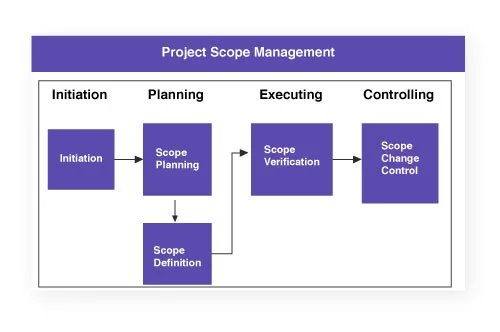
During the planning phase, a project manager documents the objectives and deliverables of the project. For successful completion of the project, defining the project’s scope is vital. You can close the project only when you achieve all the set goals.
To better understand the scope, project managers have a series of conversations with the client. Understanding the scope results in the successful outcome of the project.
The project scope document usually contains the following aspects:
- Justification.
- Scope description.
- Business objectives.
- Project Deliverables.
- Project exclusions.
- Constraints.
- Assumptions(Constraints that you cannot measure accurately).
This is the first step you take in defining the project. The scope statement serves as the primary source of information for the project team.
What is Project Scope Management?
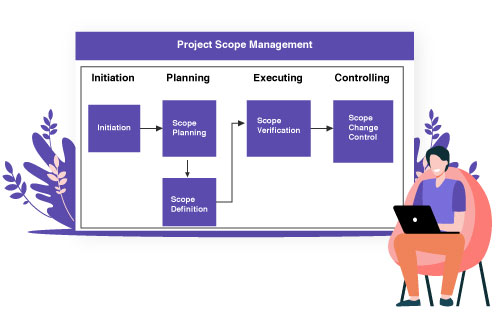
It is a set of processes that ensures the scope remains unchanged throughout the project lifecycle. A project comes with numerous uncertainties. While managing those uncertainties, you must be careful not to alter the scope. This is why scope management is vital for your project’s success. It ensures that the result is what the client expects from the project.
You can also define it as a process that simplifies your scope documentation process. It simply streamlines the workflow and maintains the focus on the scope.
Steps Involved in Project Scope Management
- Plan scope management.
- Collect requirements.
- Define scope.
- Create a Work Breakdown Structure.
- Validate scope.
- Control scope.
We will discuss each of these in detail to gain a better understanding of the process.
1. Plan scope management:
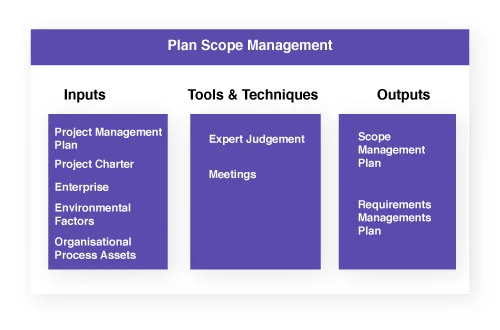
Undoubtedly there are various ways to create a scope document. In this phase, the project manager defines the scope to suit the organization’s standards. The scope management plan reduces future risks to the scope. It identifies areas that might cause serious damage to the scope and rectifies it. This is the initial step that says how you will maintain the scope throughout the project.
2. Collect requirements:
In an organization, there are a lot of parties involved who make the decision. It is not just between the manager and the client. The project manager must collect the requirements from all the authorities involved. You can also start making prototypes to see whether it fits the client’s requirements.
3. Define scope:
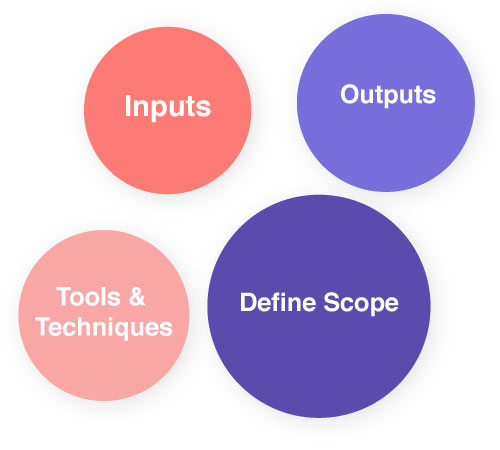
After making these plans, you must start scrutinizing each step. You must make sure that all the steps carried out favor the scope. In this phase, you will draft your final project scope statement. It must contain all the elements mentioned earlier in this blog.
You also include a list of processes that are unnecessary for the project. It is an important document that avoids future confusion in the project.
As a scope of project example, consider an aircraft manufacturing unit. The client specifies that the aircraft must have a heat-resistant coating. But it is a necessity to mention to avoid certain heat-resistant coating procedures. This is where the scope document becomes useful. The employee can easily look at the scope statement and find the excluded processes list.
4. Create a Work Breakdown Structure:
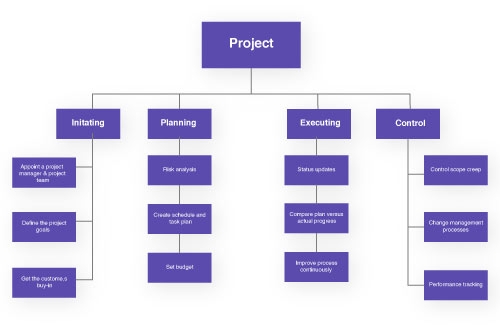
By referring to the plan and scope document, it is time to create a WBS. Work breakdown structure enables the project manager to break the project into smaller tasks. It is a part of scope management because even the small tasks must remain inside the project’s scope.
WBS prevents the straying of small tasks. It also prevents the isolation of tasks. Establishing WBS is a critical step in keeping the team engaged on the right path.
5. Validate scope:
Until now, the project scope has been nothing more than a draft. To become an official document, you have to get it approved by the respective authorities. The draft may receive change requests from either the client or the stakeholder. Only after it gets the final approval, it transforms into a proper scope document that your employees can refer to.
To ease the process of approval, you can use project management software. It streamlines the process and increases the security of the scope document. Acting as the centralized communication platform, it efficiently saves time and manual labor.
6. Control scope:
This is an important part of project scope management. The primary aim is to keep the project within the scope. It is exactly what the control phase strives to achieve. By laying out guidelines to monitor the project, it effectively manages to keep the project within its scope.
Sometimes you may need to change the scope or alter it according to customer requests. By creating detailed reports, you must see whether the new scope fits your business goals. Thus, constantly filling any gaps in the efficiency of the project.
Good scope management improves communication between the organization and the client. You can retain clients for future projects by delivering successful projects. Client satisfaction increases when the project is just what they expected.
Importance of project scope management
As a business grows, so does the complexity of each project. With proper tools, you can simplify the process. But, you also need proper strategic plans to keep the essence of the project afloat. The following are some reasons why scope management is important for a project:
1. Distinct objectives:
Having a clear-cut objective is always of importance for a project. A well-defined goal is the starting point in the journey of a project. It will help your team stay on track at all times. It also gives you a way of measuring the effectiveness of your plans.
2. Establishes a smooth workflow:

One of the steps of scope management is creating a work breakdown structure. A WBS is a tool that helps you delegate tasks and maintain integrity at the same time. A detailed WBS provides your employees with the right way of approaching the task. It also promotes accountability within the organization.
3. Better understanding:
The scope statement serves as a constant reminder of why we are doing the project. Different teams will be working on different parts of the project. To easily understand how each task contributes to the project, a scope document is vital.
The WBS gives the client a better understanding of the deadlines and deliverables. As a project manager, your job of creating assessment reports becomes easier.
4. Better decision-making:
To aid in the decision-making process, the scope document serves as the primary reference document. If not for the scope document, you would have to go through huge contracts to find the small detail you are looking for. Every crucial detail is clearly outlined in the scope document. It helps not just the manager but also the client in making proper decisions.
5. Better control:
Establishing the scope is a process that takes time and effort. But it simplifies things in the future. As a project manager, you gain better control over the processes. You can evaluate every step with the scope to see if it benefits the organization.
Scope management not only helps in control over the existing process but also helps in change control. Whenever any change happens within the scope, it reduces the impact it has on other factors involved.
Thus project scope management improves the overall quality of the project and the organization. With scope management, your client is well-engaged, and the project is well-managed at all times.
Conclusion
The scope of a project plays an important role in determining its flow. At the same time, scope management ensures that the project remains within the initial scope. It is like writing your to-do list for the day on a sticky note. It serves as a constant reminder of what you should do and how you should do it. Employ project scope management in your organization and start reaping the benefits!



